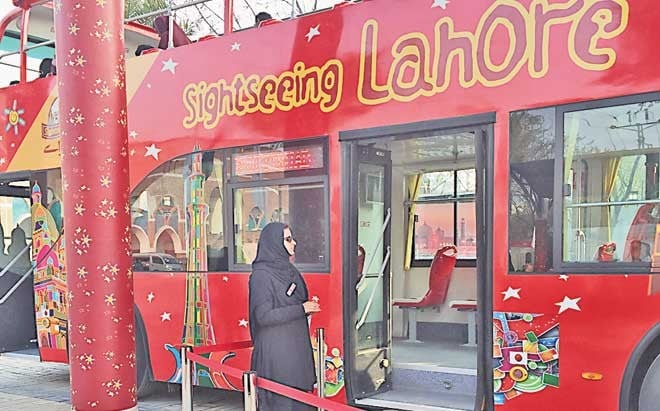

The shiny, red bus brightens up Lahore’s landscape like a beacon screaming for attention. It’s a double-decker, much like any double-decker tourist bus in the world, and promises the same kind of experience. Lahore does have a wealth of landmarks, like centuries’ old Mughal architecture (obviously the focal point of the tours) and catching the grandeur from the bus top actually helps you time travel back to an era when emperors and warriors rode on elephants. The aerial view does allow you a fresh perspective.
The logistics: the tours embark from Gaddafi Stadium (a name that makes us wonder why we still call it that) and for PKR 200 you can book an itinerary of your choice. There are basically three choices: a non-stop round trip to the Badshahi Mosque, a round trip with a one-hour break at Food Street and a round trip with a one-hour break at Lahore Fort. The booking and reservation staff at the terminal is extremely cordial and helpful with any queries you may have. It is advisable to pick up your tickets in advance, especially if you’re planning a weekend excursion.
The bus: the service started in November 2015 so the buses are still shiny and new. Autumn/winter is the ideal season for an outdoor experience but with the roof-top half-covered for shade and shelter, it may not even be so bad in summer. The bus moves fast enough for a breeze to keep things properly ventilated. The acoustics, however, are disappointing. The travel guide posted at the front of the bus could not be heard at the back as traffic and wind-noise deafened out every word she said. She moved back when we requested but then people at the front couldn’t hear her. Not that her script was overtly informative or entertaining. Having traveled on London’s Big Bus, one is familiar with interactive, humorous guides who amplify the experience by cracking jokes and sharing trivia that is not common knowledge. This tour guide did give some exclusive information but it wouldn’t have been enough to have benefitted a foreign tourist, for example. He would have learnt every intricate detail about the development of the Metro bus service, though. That was mentioned several times. Back to the sound-quality, one would recommend an installation of ear-plugs and provision of brochures so people can actually hear the narrative and come away with some solid information on Lahore’s rich architecture.
Safety Measures: Sitting atop the Lahore Sightseeing Bus is not the same as perching precariously on the roof of a W-11, for example, but it is not fool-proof either. Since children travel free of cost, their seats are not accounted for (at least they were not the day we travelled) with the result that five children were clamoring over the two seats in front of us. The bus is open-roof, which means that a ‘child-overboard’ hazard wasn’t altogether far-fetched. Authorities should strictly implement a one passenger per seat rule and make seat belts mandatory.
The sights and sounds of Lahore: Lastly, the reason why one jumps on this tour: Lahore’s landscape. Leaving the Gaddafi Stadium, the bus outlined the canal as it swaggered its way across Jail Road, through Mall Road, towards the Walled City. We drove past the heavily armoured walls and gates of Kinnaird College, Punjab University and Government College, which looked nothing like the carefree institutions that we studied at in the nineties. One can imagine this drive to be colourful and green in spring when amaltas trees are in full bloom and sun-kissed flowers bloom merrily down the stretch of Mall Road; in December much of the landscape was bleak and dreary. But not even the grey weather could deplete the Walled City of its majestic grandeur. There was a personality to the masseuses that sprawled out on the footpaths, ready for service with tiny, tinkling vials of various oils. Every sign and billboard in the Walled City, advertising political candidates, spiritual guides or even witch doctors threw a shaded light on what went on beyond its red brick walls. And the epicenter of it all was the majestic façade of the Badshahi Mosque that rose beyond hoardings and traffic and electricity poles when you made the turn on Ring Road. It made one wish for the city to reclaim itself from the ambush of ‘civilization’ as we see it (or rather suffer it) today.